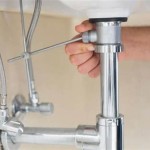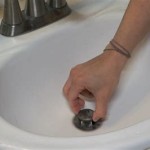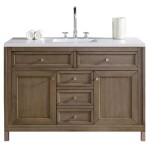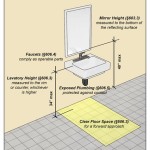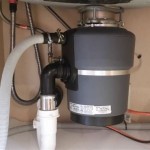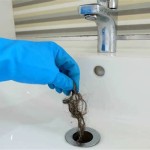Understanding Kitchen Sink Faucets: The Wall Mount Option
Kitchen sink faucets are essential components in any culinary space, providing access to water for various tasks, from dishwashing to food preparation. While countertop models are prevalent, wall-mount faucets offer a distinct alternative with unique advantages and considerations. This article delves into the intricacies of wall-mount kitchen sink faucets, examining their characteristics, benefits, installation requirements, and the factors to consider when selecting the appropriate model.
The functional design of a kitchen sink faucet is integral to the efficiency and aesthetics of the kitchen. Choices range from traditional two-handle models to modern single-handle designs equipped with features like pull-down sprayers and touchless activation. The material composition also plays a significant role, with options including stainless steel, brass, and chrome, each offering different levels of durability, resistance to corrosion, and visual appeal.
Wall-mount faucets differ significantly from their deck-mounted counterparts in installation and overall appearance. Instead of being mounted on the countertop or directly to the sink, they are installed on the wall behind the sink. This design choice provides a clean, streamlined look and can be particularly advantageous in certain kitchen configurations.
Advantages of Choosing a Wall-Mount Kitchen Faucet
Wall-mount faucets present several key advantages that make them a compelling choice for many homeowners. These advantages relate to space saving, ease of cleaning, and aesthetic appeal.
One of the primary benefits is the optimization of countertop space. By relocating the faucet to the wall, the area around the sink becomes less cluttered. This is especially beneficial in smaller kitchens where every inch of counter space is valuable. The freed-up space can be utilized for food preparation, appliance placement, or simply to create a more open and organized environment.
Another advantage lies in the enhanced ease of cleaning. With no faucet base to work around on the countertop, cleaning the sink area becomes simpler and more efficient. There are fewer crevices and edges where dirt and grime can accumulate, leading to a more hygienic surface. This can be particularly appealing to those who prioritize cleanliness in their kitchens.
Furthermore, wall-mount faucets contribute to a unique and often more modern aesthetic. The absence of a faucet base on the countertop creates a visually cleaner look, which can complement minimalist or contemporary kitchen designs. The exposed plumbing can also be incorporated into the design, adding an industrial chic element to the space. The visible pipework, combined with the faucet's spout, presents a visually appealing element that can enhance the overall design of the kitchen.
Installation Considerations for Wall-Mount Faucets
Installing a wall-mount faucet requires careful planning and precise execution. Unlike deck-mounted faucets, which can often be retrofitted into existing sink setups with relative ease, wall-mount faucets necessitate plumbing modifications within the wall cavity. This typically entails hiring a qualified plumber to ensure proper installation and prevent leaks or water damage.
The placement of the plumbing within the wall is crucial. The hot and cold water supply lines must be positioned accurately to align with the faucet's connections. This often requires opening the wall to access the existing plumbing and potentially rerouting pipes. The height of the faucet above the sink must also be carefully considered to ensure adequate clearance for washing dishes and filling pots. Too low, and it will impede usage; too high, and it will cause excessive splashing.
Another critical aspect is guaranteeing adequate support for the faucet. The wall must be structurally sound enough to bear the weight of the faucet and withstand the stress of repeated use. Reinforcements may be necessary within the wall to provide additional support, particularly if the wall is constructed of drywall alone. Framing behind the finished wall material provides a solid backing for the faucet to be mounted on, preventing movement and potential damage.
Professional installation is highly recommended for wall-mount faucets to avoid common pitfalls such as leaks, improper alignment, and structural damage. A qualified plumber possesses the expertise and tools to handle the complexities of wall-mount faucet installation, ensuring a secure and functional setup. This includes properly sealing the faucet connections, testing for leaks, and verifying that the water pressure is within acceptable parameters.
Before installation, it is also imperative to check local plumbing codes and regulations. Some jurisdictions may have specific requirements regarding the installation of wall-mount faucets, including the type of piping allowed and the placement of shut-off valves. Adhering to these codes ensures compliance and prevents potential legal issues down the line.
Factors to Consider When Selecting a Wall-Mount Faucet
Choosing the right wall-mount kitchen faucet involves careful consideration of several factors, including spout reach, style, finish, and functionality. The ideal faucet will not only complement the kitchen's aesthetic but also meet the user's specific needs and preferences.
The spout reach, or the distance the faucet extends over the sink, is a crucial consideration. It determines the area of the sink that the water stream can reach, which impacts washing effectiveness and convenience. A spout that is too short may not reach the center of the sink, while one that is too long could cause splashing. Selecting the appropriate spout reach depends on the size and shape of the sink.
The style of the faucet should align with the overall aesthetic of the kitchen. Wall-mount faucets are available in a variety of styles, ranging from traditional to modern, allowing homeowners to find a model that complements their existing décor. Common stylistic choices include gooseneck spouts, which offer ample clearance for filling tall pots, and minimalist designs with clean lines. The chosen style should also harmonize with other fixtures and appliances in the kitchen.
The finish of the faucet is another important consideration. Common finishes include stainless steel, chrome, and brushed nickel, each offering different levels of durability and visual appeal. Stainless steel is known for its resistance to corrosion and its modern look, while chrome offers a classic, shiny finish. Brushed nickel provides a softer, more subtle look and is less prone to showing fingerprints. The chosen finish should also be resistant to tarnishing and scratching to maintain its appearance over time.
Functionality is also a key factor. Some wall-mount faucets come equipped with features such as pull-down sprayers, which offer greater flexibility when washing dishes or rinsing the sink. Others feature touchless activation, allowing users to turn the water on and off without touching the faucet, promoting hygiene and conserving water. Consider the specific needs of the household when assessing the functionality of different wall-mount faucet models.
Finally, it is essential to consider the quality and reliability of the faucet. Opting for a reputable brand with a strong warranty can provide peace of mind and ensure that the faucet will function properly for years to come. Reading customer reviews and seeking recommendations from professionals can also help inform the decision-making process.
In conclusion, wall-mount kitchen sink faucets present a unique and often advantageous alternative to traditional deck-mounted models. Their space-saving design, ease of cleaning, and aesthetic appeal make them a compelling choice for many homeowners. However, the installation requires careful planning and professional execution to avoid potential problems. By considering the factors outlined in this article, homeowners can make an informed decision and select a wall-mount faucet that meets their specific needs and enhances the functionality and beauty of their kitchen.
The market offers a wide variety of wall-mount kitchen faucets, including options made from different materials and featuring various designs. It is important to research thoroughly before making a purchase. Look for brands that are known for their quality and durability. Also, take into consideration the warranties offered by the manufacturer. A longer warranty period usually indicates a higher level of confidence in the product's reliability.

Wall Mount Black Kitchen Sink Faucet Pull Down Spray Swivel Spout Mixer Tap

Kitchen Sink Faucet 8 In Center 2 Handle 10 Swivel Spout Wall Mount

Bwe 2 Handle Wall Mount Kitchen Faucet With 12 Inch Swivel Spout 8 Center In Polished Chrome A 94255

Kitchen Faucet 8 In Center Wall Mount 2 Handle Swivel Sink Mixer Tap

Gotonovo Kitchen Sink Faucet Wall Mount 6 Inch 8inch Center Adjustable Hole Distance Faucets 360 Degree Swivel Spout Double Cross Handles

Waterloo Wall Mounted Faucet With 8 Centers And Swing Spout

Gotonovo Wall Mount Kitchen Faucet 8 Inch Center Kit

Foldable Kitchen Faucets Solid Brass Sink Mixer Tap Hot Cold Wall Mounted With Bidet Sprayer Rotating China Faucet Made In Com

Wall Mounted Faucets Pros And Cons Watersino

Bwe Double Handle Wall Mount Standard Kitchen Faucet With 8 In Swivel Spout Center Polished Chrome A 94256
